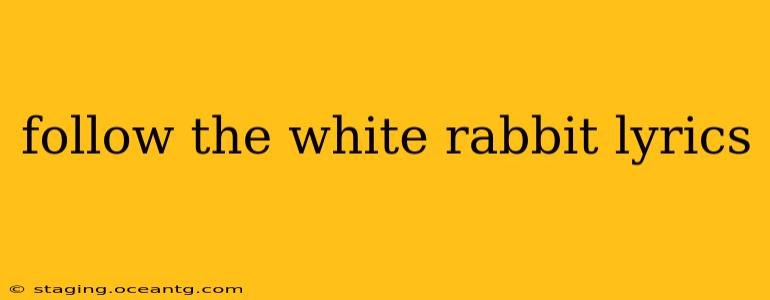Jefferson Airplane's "White Rabbit" isn't just a song; it's a psychedelic journey, a cryptic riddle wrapped in a catchy melody. Since its release in 1967, it's captivated listeners with its ethereal soundscape and enigmatic lyrics, sparking endless interpretations and cementing its place in rock history. This exploration dives deep into the lyrics, their meaning, and the lasting impact of this iconic track.
What is the Song "White Rabbit" About?
The song's central theme is a potent blend of allegory and allusion, primarily drawing inspiration from Alice's Adventures in Wonderland. Grace Slick, the vocalist, masterfully weaves together references to Lewis Carroll's fantastical tale, creating a narrative of mind-expansion and the exploration of altered states of consciousness. The "white rabbit" itself symbolizes a guide into a world of surreal experiences, perhaps representing the allure of drugs or the intoxicating pursuit of knowledge and self-discovery. The song encourages listeners to embrace the unknown, to follow their curiosity, even if it leads them down a rabbit hole of uncertainty.
What Does "One Pill Makes You Larger" Mean?
This line, arguably the most recognizable in the song, is a direct reference to the hallucinogenic effects of drugs. "One pill makes you larger, and one pill makes you small," is a powerful metaphor for the unpredictable and transformative nature of these substances. It highlights how altering one's perception can drastically change one's perspective on reality, leading to both euphoric highs and potentially unsettling lows. The line's simplicity and stark imagery contribute to its enduring power and resonate with those familiar with the experiences of altered consciousness.
What are the Other References in "White Rabbit"?
The song is richly layered with symbolic references beyond Alice in Wonderland. The lines referencing "feed your head" and "going to the pillman" are clearly related to drug use, suggesting a conscious decision to embrace these experiences. However, the lyrics also allude to broader themes of societal control, questioning and defying established norms and beliefs. The song's ambiguity allows for multiple interpretations, inviting listeners to connect their own experiences and perspectives to the narrative.
Is "White Rabbit" Just About Drugs?
While the song's drug references are undeniable, reducing its meaning solely to drug use would be a gross oversimplification. The song's deeper message resonates with anyone who has ever embarked on a journey of self-discovery, faced uncertainty, or challenged societal expectations. It's a call to question reality, explore the unknown, and embrace the transformative power of experience, regardless of the means. The use of Alice's journey acts as a universal metaphor for the process of personal growth and exploration.
Why is "White Rabbit" Still Relevant Today?
"White Rabbit" continues to resonate with audiences decades after its release due to its timeless themes. The exploration of altered states, the pursuit of knowledge, and the questioning of authority are experiences that remain relevant across generations. The song's evocative lyrics, combined with its captivating melody and psychedelic soundscape, create an enduring piece of art that transcends its specific historical context. The ambiguity of the lyrics also allows for continuous reinterpretation, ensuring its continued relevance for new audiences.
What Makes "White Rabbit" Such a Classic?
The song's enduring appeal stems from a confluence of factors. Its iconic melody is instantly recognizable and incredibly catchy. Grace Slick's haunting vocals perfectly capture the song's ethereal and mysterious atmosphere. Finally, the enigmatic lyrics, open to multiple interpretations, ensure that the song continues to spark discussion and engage listeners on multiple levels. Its blend of musical brilliance and lyrical profundity solidify "White Rabbit's" status as a true classic of psychedelic rock.
This in-depth exploration of "Follow the White Rabbit" aims to provide a nuanced understanding of the song's complex layers of meaning. While the drug references are undeniable, the song's true power lies in its universality; it's a story of exploration, transformation, and the courage to question the world around us.
